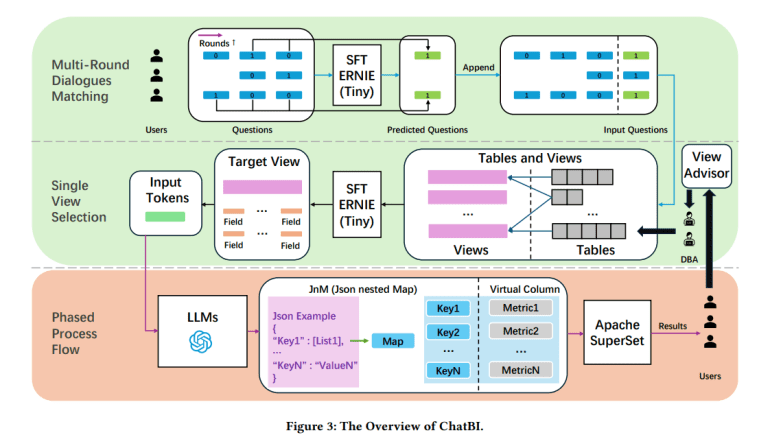- Large Language Models (LLMs) are transforming Natural Language to SQL (NL2SQL) tasks.
- ChatBI addresses NL2BI challenges, empowering non-experts with BI query capabilities.
- Existing NL2SQL methods struggle with Multi-Round Dialogue (MRD) scenarios in BI contexts.
- Researchers propose innovative solutions for effective MRD interaction handling and schema linking.
- ChatBI outperforms mainstream NL2SQL methods in accuracy and efficiency evaluations.
Main AI News:
The recent surge in Large Language Models (LLMs) has ignited a wave of interest across academic and industrial circles. Researchers from both the Natural Language Processing (NLP) and database domains are delving into the potential of LLMs to tackle the Natural Language to SQL (NL2SQL) task, which involves translating natural language queries into executable SQL statements aligned with user intent.
As numerous enterprises harness Business Intelligence (BI) for decision-making support, industry experts have turned their attention to NL2BI, a domain where natural language seamlessly transforms into BI queries. NL2BI empowers non-technical users, including product managers and operations staff, to conduct data analysis, streamlining decision-making processes.
In the realm of Natural Language to Business Intelligence (NL2BI), human interaction assumes a critical role, often manifesting in Multi-Round Dialogue (MRD) scenarios where users engage in iterative conversations to refine queries. Existing NL2SQL methodologies predominantly cater to Single-Round Dialogue (SRD) queries and encounter difficulties in handling MRD scenarios. Consequently, the transition to intricate BI queries, such as Week-on-Week comparisons, poses challenges for conventional NL2SQL approaches. Furthermore, disparities in data table structures between BI and traditional SQL environments further exacerbate the translation complexities.
Researchers have primarily concentrated on enhancing NL2SQL methodologies, which encompass pre-trained models, Supervised Fine-Tuning (SFT) techniques, prompt engineering-based LLMs, and LLMs specifically tailored for NL2SQL. However, when confronted with real-world BI scenarios, these methodologies confront limitations, particularly in effectively addressing MRD interactions. Persistent challenges revolve around accurately distinguishing between SRD and MRD queries, as well as adapting prompt engineering strategies to accommodate MRD scenarios.
In response to these challenges, researchers propose innovative solutions customized for the NL2BI landscape. They introduce methodologies to adeptly handle MRD interactions and streamline schema linking into a single view selection quandary, capitalizing on database view technology. Additionally, they advocate for a phased process flow in query generation, emphasizing structured intermediate outcomes to adeptly manage complex semantics and comparison relationships.
Enter ChatBI: a pioneering solution deployed in production environments and seamlessly integrated into multiple product lines. Comparative evaluations against mainstream NL2SQL methodologies underscore ChatBI’s superiority in terms of accuracy and efficiency. By addressing the distinctive challenges inherent in NL2BI scenarios and harnessing structured intermediate outcomes, ChatBI epitomizes a significant leap forward in natural language-driven BI query generation, empowering non-technical users and fostering informed decision-making processes.
Conclusion:
The introduction of ChatBI signifies a pivotal moment in the market, where natural language-driven BI query generation becomes more accessible and efficient. This advancement holds the potential to revolutionize decision-making processes, enabling non-technical users to harness the power of Business Intelligence for informed strategic decisions, thus driving competitiveness and innovation across industries.

